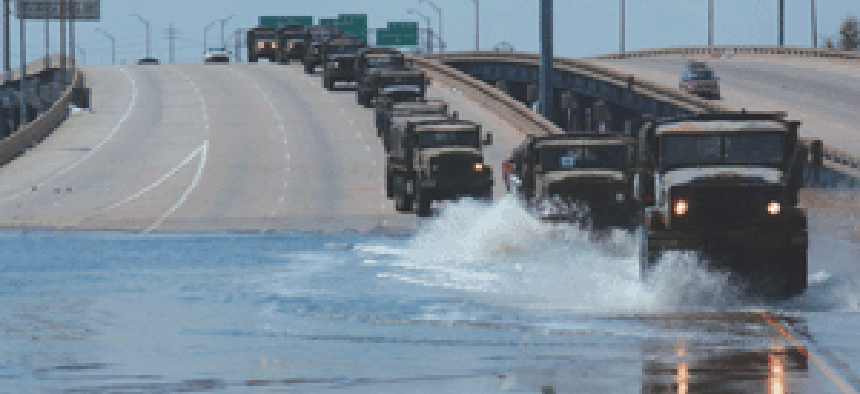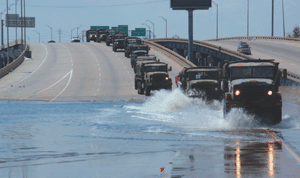Signal Brigade

Editor's Note: Government Computer News Staff Writer Dawn S. Onley was embedded from Sept. 7 to Sept. 13 with an Army unit during its mission to areas affected by <BR>Hurricane Katrina.
Temperatures simmered in the mid-90s and the humid air was thick with mosquitoes, flies and other airborne nuisances during the six days I spent at Camp Shelby, Miss., embedded with the Army's 93rd Signal Brigade.The brigade, based at Fort Gordon, Ga., came to Camp Shelby, headquarters for Joint Task Force Katrina recovery efforts, to set up a voice, video and data infrastructure for the southeastern part of the state.From there, I traveled to New Orleans to talk with members of the 56th Signal Battalion, part of the 93rd Signal Brigade.The 56th was deployed to the New Orleans International Airport, supplying communications to the 13th Core Area Support Command out of Fort Hood, Texas, which in turn supports soldiers deployed to the city's downtown area.Army Capt. Julian Stamps, 518-Tactical Installation and Network Company commander under the 56th battalion, said setting up the computer infrastructure has been relatively easy. That's what military signal divisions do best during emergency deployments: ensure that troops can talk to one another via phone, Internet and videoconference.But for these soldiers, who sleep on cots inside Concourse A in the terminal and walk about a quarter-mile to take a shower, the most difficult part has been getting food and rest.The day after Hurricane Katrina ravaged the Gulf Coast, members of the 93rd Signal Brigade began driving caravans of communications equipment to Camp Shelby to set up a communications infrastructure for southeastern Mississippi.When about 80 soldiers arrived at Camp Shelby -- headquarters and temporary home to Lt. Gen. Russel Honore, who's leading military relief efforts for Katrina -- they found very limited communications capability.Roughly 120 brigade soldiers are doing similar work in New Orleans and Baton Rouge, La. The soldiers come from either the brigade's 67th or 56th Signal Battalion."We are very similar to Cox Cable and Bell South. We go into an austere environment, and we give you your Internet connection and telephone connection," said Col. David Dodd, 93rd Signal Brigade commander. "We also do that for the Army at wartime."The units are providing tactical satellites, data switching and multiplex equipment, and secure and nonsecure voice, video and data support to the Army, the Federal Emergency Management Agency and the Defense Department's joint task force.The first big test for the brigade came just 48 hours after it arrived when it had to hook up a videoconference between President Bush in the White House and Honore. The videoconference was to last 17 minutes; it went an hour and 15 minutes."We didn't want any errors. It was perfect," Dodd said.In February, members of the 93rd Signal Brigade, a subordinate unit of the Army's Network Enterprise Technology Command/9th Army Signal Command, came back from a year's deployment in Iraq. A month later, the communications equipment and tactical trucks returned by ship, and from March through August, units fixed and maintained the equipment. That same equipment is now at Camp Shelby, officials said."Everything they're using here is being used in Iraq," Dodd said.The operations center in this austere military training camp is the heart of Hurricane Katrina rescue efforts. Using laptop PCs, military personnel communicate via satellite phones or instant messaging with rescue workers on the ground in New Orleans. On a digital screen at the front of the room is a grid of the city, showing areas by ward and the number of rescue workers in each ward.The grid runs over the Command and Control Personal Computer (C2PC) software system, a tactical map display designed by the Marine Corps. C2PC runs on Microsoft Windows and lets users exchange tactical position data with Unix systems, such as the Global Command and Control System (GCCS) and the Tactical Combat Operations System. The C2PC can also display data from the GCCS Common Operational Picture.Transportation Department traffic cameras give the staff a glimpse of what is happening at various intersections across New Orleans. Surveillance planes also fly above the city, shooting images and feeding them to PCs in the operations hub.Army Maj. John Rogers, acting chief of operations, said personnel in the operations center are providing vital situational awareness and management for search and rescue missions. The result, according to Rogers, is that the center is helping to save lives."Our mission is to support FEMA in any way we can do so and to save as many American citizens as we can," Rogers said. "We're methodically searching the areas and making sure everyone who wants help gets help."For more of Dawn Onley's coverage from the Gulf Coast, visit the Web site of our sister publication, www.gcn.com. Onley can be reached at onley@postnewsweektech.com.
 Editor's Note: Government Computer News Staff Writer Dawn S. Onley was embedded from Sept. 7 to Sept. 13 with an Army unit during its mission to areas affected by
Editor's Note: Government Computer News Staff Writer Dawn S. Onley was embedded from Sept. 7 to Sept. 13 with an Army unit during its mission to areas affected by
Hurricane Katrina.

The military has been heavily involved in the recovery efforts in the Gulf Coast region, including the delivery of supplies and equipment as well as transporting of citizens.
Senior MSgt. Mike Arellano, Air Force
Hurricane Katrina.
NEXT STORY: Small business: 'We need to play on this field'

